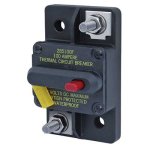pcg
Member
- Joined
- Aug 31, 2018
- Messages
- 425
- Reaction score
- 5
- C Dory Year
- 1999
- C Dory Model
- 22 Cruiser
- Hull Identification Number
- DOR22866J999
For those of you that have the Garmin Reactor 40 autopilot with a helm control (GHC 20 or GHC 50), do you have a means for turning it completely off?
I'd like to be able to eliminate parasitic draw when I'm boondocking. I'm poring over the GHC 50 manual and there doesn't seem to be a means of turning the Reactor 40 completely off from that device, although you can program it to go into SLEEP mode, and the GHC 50 will be off as well anyway when boondocking.
I was originally thinking I would power the Reactor 40 from a power bus that all other electronics receive power from, and have a switch at the helm to shut off power to that bus. However, the Reactor 40 power cable requires a 40A fuse so I would need a relay if I wanted to shut it off from a switch at the helm. The problem is a 50A relay draws 3A just from coil current. I know the autopilot averages considerably more than that when in use, but I'd sure like to avoid another 3A when underway if I don't need to, particularly during long periods traveling at displacement speed when the outboard alternator is not producing a lot of current. So how are you turning your autopilot completely off when not underway?
I'd like to be able to eliminate parasitic draw when I'm boondocking. I'm poring over the GHC 50 manual and there doesn't seem to be a means of turning the Reactor 40 completely off from that device, although you can program it to go into SLEEP mode, and the GHC 50 will be off as well anyway when boondocking.
I was originally thinking I would power the Reactor 40 from a power bus that all other electronics receive power from, and have a switch at the helm to shut off power to that bus. However, the Reactor 40 power cable requires a 40A fuse so I would need a relay if I wanted to shut it off from a switch at the helm. The problem is a 50A relay draws 3A just from coil current. I know the autopilot averages considerably more than that when in use, but I'd sure like to avoid another 3A when underway if I don't need to, particularly during long periods traveling at displacement speed when the outboard alternator is not producing a lot of current. So how are you turning your autopilot completely off when not underway?

